Headless ecommerce revolutionizes the way online businesses operate, emphasizing flexibility and innovation. This headless architecture decouples an online store's front and back end, enabling businesses to deliver unparalleled customer experience across various channels. This approach contrasts with traditional commerce, offering enhanced control over the user experience and facilitating seamless integration of new technologies.
Aloa, an expert in software outsourcing, understands the significance of headless commerce in modern ecommerce. Aloa's expertise can assist businesses in implementing a headless commerce solution tailored to their specific needs. By leveraging headless ecommerce platform capabilities, businesses can optimize their online store and streamline business operations while adapting to evolving customer expectations.
In this blog, you will understand headless commerce comprehensively, including its benefits, critical considerations for choosing a commerce platform, and the benefits of a successful implementation. Afterward, you will understand the importance of adopting a headless commerce approach in today's digital landscape to drive business growth and deliver exceptional ecommerce experiences across multiple channels.
Let's begin!
What Is Headless Ecommerce?
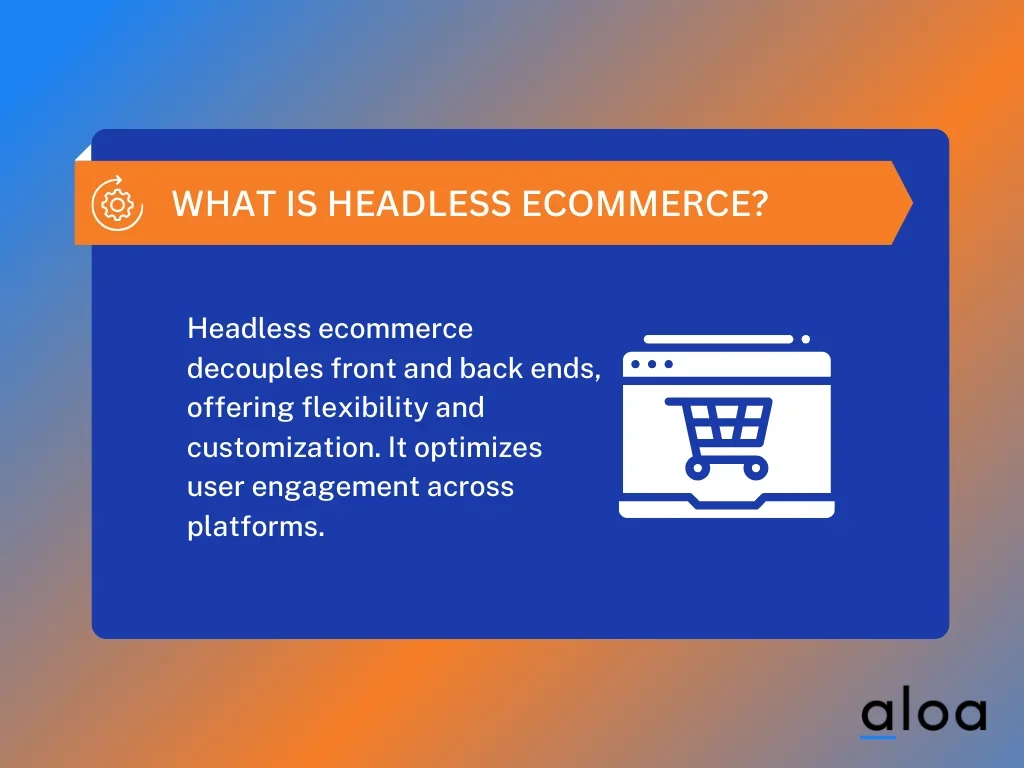
Headless ecommerce is a commerce architecture where the front and back end of an ecommerce platform are decoupled, allowing for greater flexibility and customization. This architecture separates the presentation layer or user interface from the commerce engine or backend, enabling ecommerce businesses to deliver a more tailored shopping experience.
This model seamlessly integrates new features, relying on powerful APIs for data exchange and application programming interface (API) calls. Moreover, headless ecommerce platforms enable businesses to optimize user engagement by delivering personalized experiences across various platforms, including mobile apps, IoT devices, and social media.
Differences Between Headless vs Traditional Ecommerce
When considering headless vs traditional ecommerce, there are significant disparities that businesses must grasp to make informed decisions. Here are five key differences:
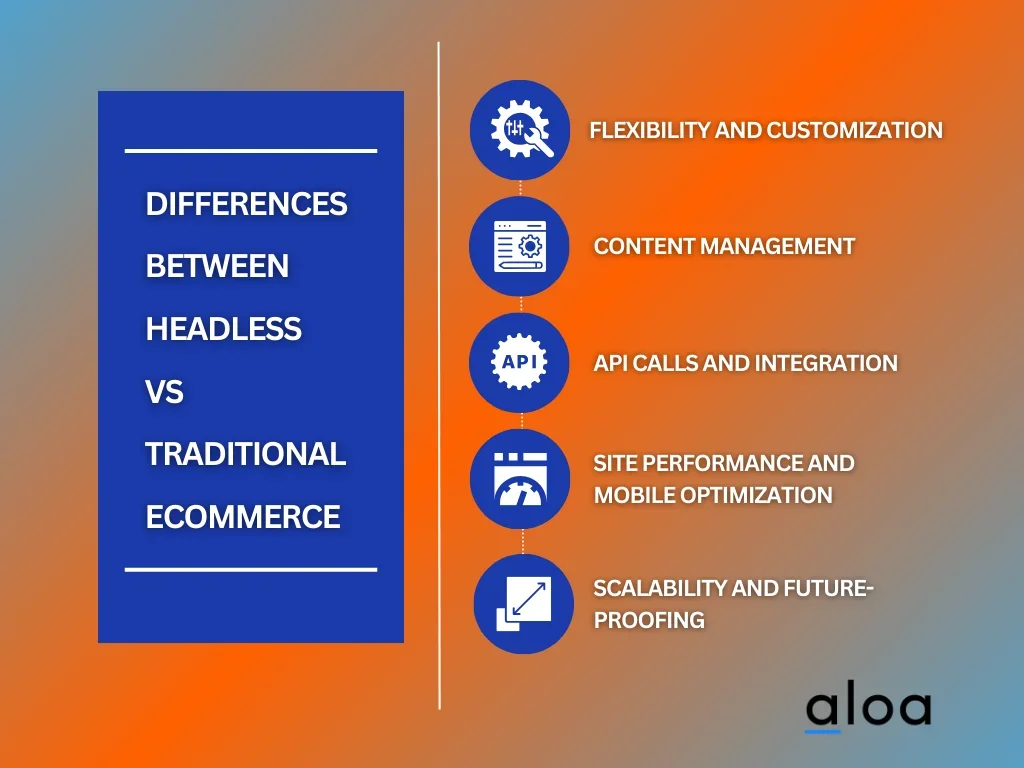
Flexibility and Customization
Headless ecommerce allows for unparalleled flexibility and customization. Unlike traditional architectures, where the frontend and backend are tightly integrated, headless architecture decouples the presentation layer from the backend, enabling businesses to tailor user experiences across different channels. This ease of use empowers developers to experiment with various technologies and frameworks, optimizing the tech stack for specific business objectives.
Content Management
With traditional ecommerce, content management is often tightly integrated into the platform, limiting flexibility. In contrast, headless commerce architecture separates content management from the ecommerce model, allowing businesses to manage content independently of the storefront. This separation facilitates more dynamic and personalized content delivery across different channels.
API Calls and Integration
Headless ecommerce relies heavily on API calls to connect the front and back end. This headless model enables seamless integration with various third-party services, enhancing functionality and expanding capabilities. Traditional architectures, on the other hand, may have limitations in terms of integration, hindering the ability to adapt to evolving market trends and technologies.
Site Performance and Mobile Optimization
Headless commerce optimizes site performance and ensures seamless experiences across mobile devices. By leveraging a headless architecture, businesses can deliver lightweight and fast-loading storefronts tailored for different devices and screen sizes. This focus on performance is crucial in today's digital landscape, where search engines prioritize mobile-friendly websites.
Scalability and Future-Proofing
The headless commerce platform provides scalability and future-proofing capabilities for growing ecommerce brands. By decoupling the front end from the back end, businesses can quickly adapt to emerging technologies and trends, ensuring long-term relevance and competitiveness. Traditional architecture may need help keeping pace with the evolving demands of the market, making headless ecommerce the best way forward for forward-thinking businesses.
How To Choose a Headless Ecommerce Platform
Selecting a headless ecommerce platform requires careful consideration and strategic planning. With the rapid evolution of ecommerce technology, choosing the right platform is crucial for scalability, customization, and seamless integration.
Let's explore the six essential steps to help you navigate the process and make an informed decision that aligns with your business needs and goals.
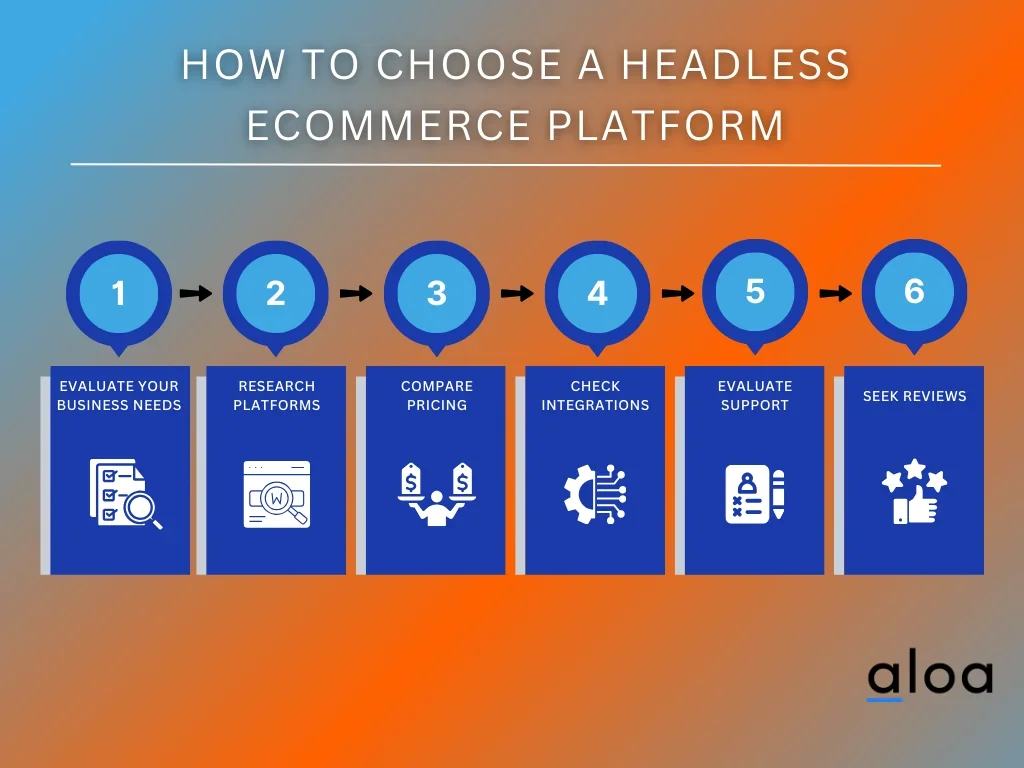
Step 1: Evaluate Your Business Needs
In the initial step of choosing a headless ecommerce platform, it's imperative to assess your business requirements thoroughly. This involves comprehensively examining various factors to ensure your selected platform aligns perfectly with your business objectives and growth aspirations. To guide this evaluation process, consider the following questions:
- How scalable does the platform need to be to accommodate future growth?
- What level of customization options does your business demand to reflect its unique branding and operational needs?
- How seamlessly can the platform integrate with existing systems, such as CRM software, inventory management tools, and third-party applications?
- What are the budgetary constraints, and how do they influence the platform selection?
You clearly understand your business's specific needs and priorities by meticulously addressing these questions. This, in turn, facilitates a more focused approach to platform selection, streamlining the decision-making process and minimizing the risk of investing in a solution that falls short of expectations.
Evaluating your business needs serves as the foundational step in the process of selecting a headless ecommerce platform. You can pinpoint the platform that best aligns with your business goals and objectives by meticulously examining scalability, customization options, integration capabilities, and budget constraints.
Step 2: Research Headless Ecommerce Platforms
In this step, we will delve into headless ecommerce platforms. These platforms decouple the frontend presentation layer from the backend commerce functionality, offering flexibility, scalability, and enhanced customization options. Understanding headless ecommerce solutions is crucial for selecting the right platform to meet your business needs.
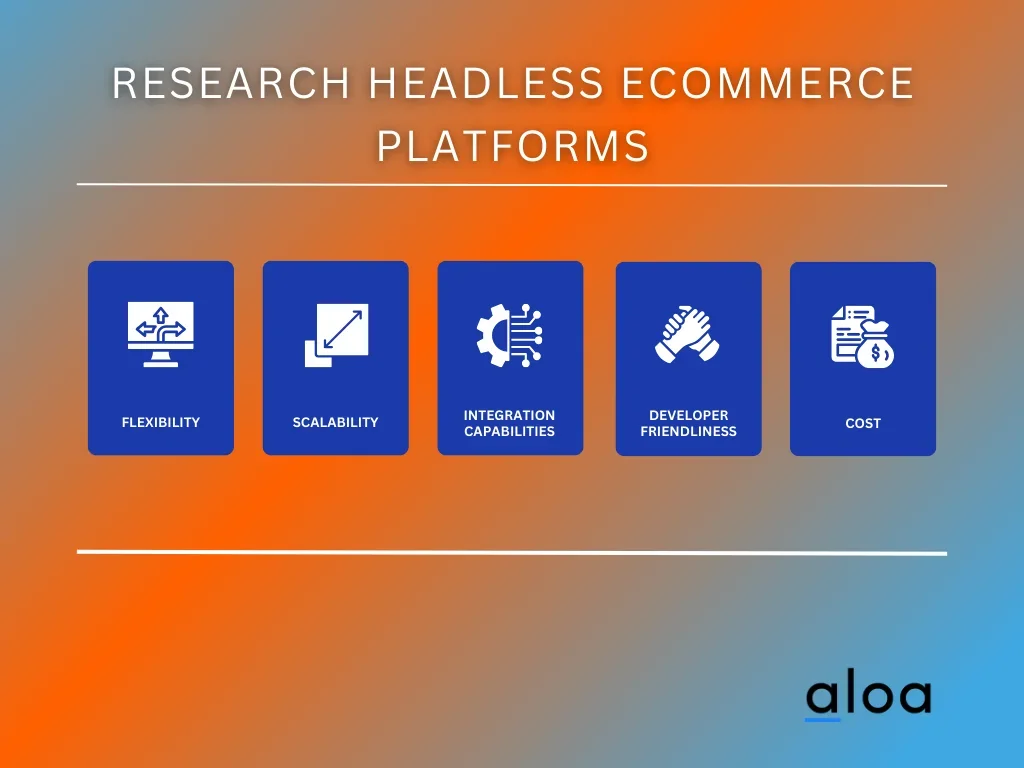
- Flexibility: Assess how easily the platform accommodates changes in design and functionality without impacting the backend commerce operations.
- Scalability: Evaluate the platform's ability to handle growing traffic and transactions without compromising performance.
- Integration Capabilities: Look into the platform's compatibility with third-party services and tools, such as payment gateways, shipping providers, and marketing automation systems.
- Developer Friendliness: Consider the ease of development and maintenance, including the availability of robust APIs and developer resources.
- Cost: Analyze the total cost of ownership, including subscription fees, development expenses, and ongoing maintenance costs.
Researching headless ecommerce platforms is a pivotal step in building a robust online store that can adapt to the evolving needs of your business. By considering factors such as flexibility, scalability, integration capabilities, developer friendliness, and cost, you can make an informed decision that aligns with your business objectives and sets the foundation for success in the digital marketplace.
Step 3: Compare Pricing Models
Navigating various pricing models is akin to steering a ship through turbulent waters. Before committing to a platform, it's essential to scrutinize the pricing structures offered by different providers meticulously. Each platform has a unique pricing model, from subscription-based plans to pay-as-you-go options.
When comparing pricing models, delve deep into the intricacies of each offering. Evaluate the base subscription fees and any additional charges that may apply. These could include transaction fees, bandwidth fees, or fees for advanced features and integrations. Assess whether the pricing model aligns with your business's financial capabilities and growth trajectory.
Furthermore, consider scalability. Will the pricing model accommodate your business's expansion without causing undue financial strain? Look for flexible platforms that allow you to adjust your plan as your business evolves. By thoroughly analyzing pricing models, you can make an informed decision that ensures long-term sustainability and profitability for your commerce architecture venture.
Step 4: Check Integration Capabilities
Integration capabilities are a cornerstone of any successful headless ecommerce platform. This step involves assessing the platform's ability to seamlessly connect with various essential tools and systems integral to running an ecommerce business. A robust integration framework ensures smooth data flow between different components of your ecommerce ecosystem, enhancing operational efficiency and enabling a superior customer experience.
Let's delve deeper into this critical aspect of platform selection:
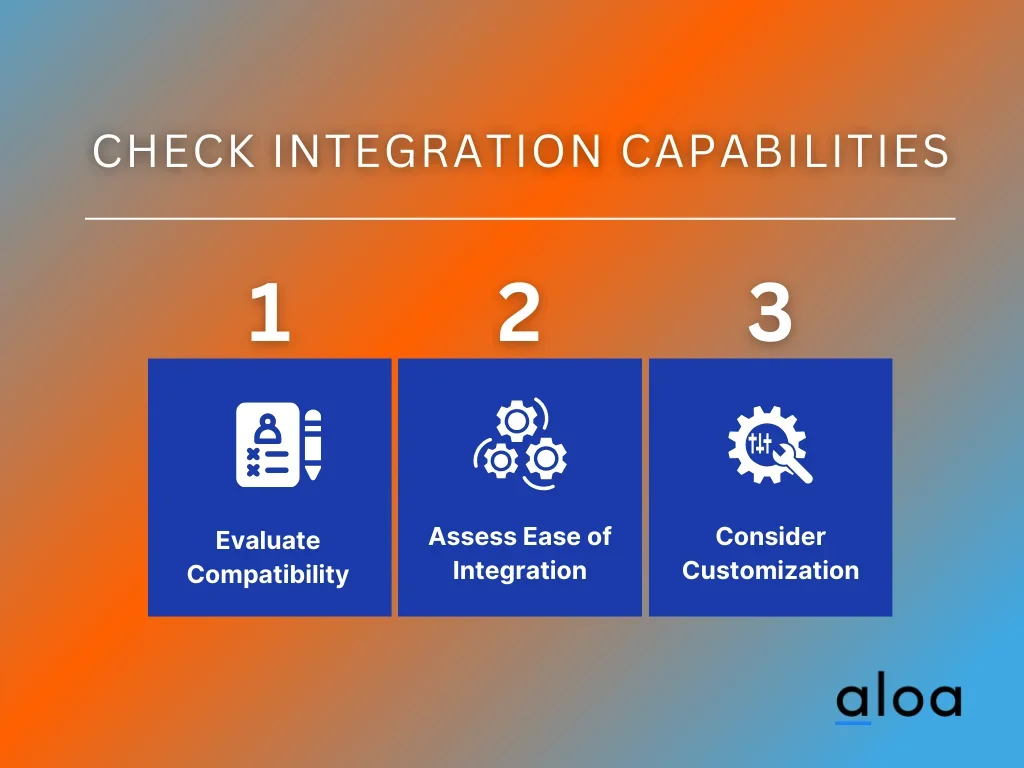
- Evaluate Compatibility: Ensure that the platform supports integration with a wide range of CRM software, marketing automation platforms, payment gateways, and third-party APIs commonly used in ecommerce operations.
- Assess Ease of Integration: Look for platforms that offer straightforward integration processes with minimal technical complexity. User-friendly integration tools and documentation can streamline the implementation process and reduce dependency on IT resources.
- Consider Customization Options: Determine whether the platform allows for flexible customization of integrations to meet unique business requirements. Customizable integration solutions empower businesses to adapt to evolving needs and leverage emerging technologies seamlessly.
Checking integration capabilities is essential for selecting a commerce architecture platform that effectively supports your business operations. By assessing compatibility, ease of integration, and customization options, you can ensure seamless connectivity between various tools and systems, laying the foundation for a cohesive and efficient ecommerce ecosystem.
Step 5: Evaluate Support and Maintenance
When selecting a headless ecommerce platform, evaluating the level of support and maintenance the platform vendor provides is paramount. This step ensures your business receives the necessary assistance and resources to overcome challenges and maintain optimal performance.
Here's a breakdown to guide you through this process:
- Timely Assistance: Access to prompt support is essential for resolving issues efficiently and minimizing downtime.
- Regular Updates: Continuous updates and enhancements ensure your platform remains secure, compliant, and equipped with the latest features and functionalities.
- Troubleshooting Services: Effective troubleshooting mechanisms are crucial for swiftly identifying and addressing any technical glitches or performance issues that may arise.
Prioritizing support and maintenance capabilities when choosing a commerce architecture platform is vital for long-term success. By partnering with a vendor that offers reliable assistance, updates, and troubleshooting services, you can ensure the seamless operation of your ecommerce infrastructure and provide an exceptional experience for your customers.
Step 6: Seek Recommendations and Reviews
Seeking recommendations and reviews is a pivotal step in selecting a headless ecommerce platform. Engaging with industry peers, whether through networking events, online forums, or professional associations, offers invaluable insights into the performance and suitability of different platforms. By tapping into the collective knowledge and experiences of fellow ecommerce professionals, you can gain firsthand perspectives on the strengths and weaknesses of various solutions.
Attending ecommerce events provides opportunities to interact with vendors, hear case studies, and witness platform demonstrations, further aiding in your decision-making process. Furthermore, delving into reviews and testimonials from current users offers authentic feedback on usability, reliability, and customer support, helping you gauge the platform's effectiveness in real-world scenarios. Ultimately, leveraging recommendations and reviews empowers you to make a well-informed choice that aligns with your business needs and objectives.
Benefits of Headless Ecommerce For Customers
Headless ecommerce presents a paradigm shift in how businesses engage with customers, offering unprecedented flexibility, personalization, and performance. This ecommerce offers many benefits tailored to enhance their experience, driving engagement, satisfaction, and loyalty.
Here are five compelling advantages:

Enhanced User Experience
Headless architecture allows businesses to create immersive and tailored experiences across various touchpoints. By decoupling the frontend presentation layer from the backend ecommerce functionality, companies can design interfaces optimized for different devices and channels. This agility empowers brands to deliver seamless, intuitive experiences that captivate customers and foster deeper connections with their brands. Shopify developers leverage this architecture to craft captivating user interfaces that prioritize intuitiveness and simplicity, increasing engagement and higher conversion rates.
Personalization and Flexibility
Headless commerce enables advanced personalization capabilities, allowing businesses to deliver content and product recommendations tailored to individual preferences and behaviors. By leveraging customer data and insights, brands can curate bespoke shopping journeys, presenting relevant products and offers in real time. This personalized approach enhances customer satisfaction, drives conversions, and increases average order value.
Omnichannel Capabilities
In omnichannel, customers expect a cohesive shopping experience across all touchpoints, whether online, offline, or mobile. Ecommerce website development using headless architecture enables seamless synchronization across various touchpoints, including web, mobile, social media, and even voice-activated devices. This unified approach ensures consistency in branding, messaging, and inventory management, fostering a cohesive omnichannel experience that resonates with customers at every interaction.
Faster Loading Times and Performance
Traditional monolithic ecommerce platforms often need help to deliver fast and responsive experiences, particularly as websites become increasingly complex with rich media and dynamic content. Headless architecture addresses this challenge by decoupling the frontend presentation layer, allowing for lightweight, optimized web pages that load quickly and perform efficiently. This improved performance enhances the user experience and positively impacts SEO rankings and conversion rates. Moreover, with optimized ecommerce hosting solutions, retailers can effortlessly handle spikes in traffic without compromising user experience.
Scalability and Future-Proofing
Headless ecommerce offers unparalleled scalability, allowing businesses to adapt and grow in response to changing market dynamics and evolving customer expectations. By decoupling frontend and backend systems, companies can easily integrate new technologies, experiment with innovative features, and scale their operations without disrupting the user experience. This flexibility future-proofs businesses, enabling them to stay agile and competitive in an ever-evolving digital landscape.
Key Takeaway
Staying updated on ecommerce industry trends is crucial for businesses to thrive in today's competitive landscape. With the growing importance of headless ecommerce, startups particularly stand to benefit from its innovative approach. This solution allows startups to stay agile and adapt quickly to changing market trends. This approach offers flexibility and scalability, essential for startups establishing a solid online presence.
Leveraging this commerce architecture is crucial for startups looking to thrive in the competitive e-commerce landscape. It provides the flexibility and scalability to adapt quickly to changing market demands. By leveraging headless ecommerce, startups can create seamless and engaging online experiences for their customers, setting them apart from the competition.
Stay up to date on the latest ecommerce insights and industry developments by signing up for our email list. You can also explore other ecommerce industry blogs through our website for more guides on what’s happening in the market today. Stay ahead of the curve and drive your e-commerce business to new heights with our expert insights and recommendations!

